The Shocking and SAD Reasons Why Corgis Tails are Docked?
Corgis, a beloved breed known for their cute and compact stature, often have their tails docked for various reasons. Historically, tail docking in Corgis was done for practical purposes, as these dogs were primarily used for herding livestock. The belief was that a shorter tail would reduce the risk of injury while working in the field, as well as make it more difficult for predators to grab onto the tail.
In modern times, many Corgis still have their tails docked, partially due to breed standards set by various dog show organizations. In some cases, certain breeds like the Pembroke Welsh Corgi are expected to have a specific appearance, which includes a docked tail, in order to compete in dog shows.
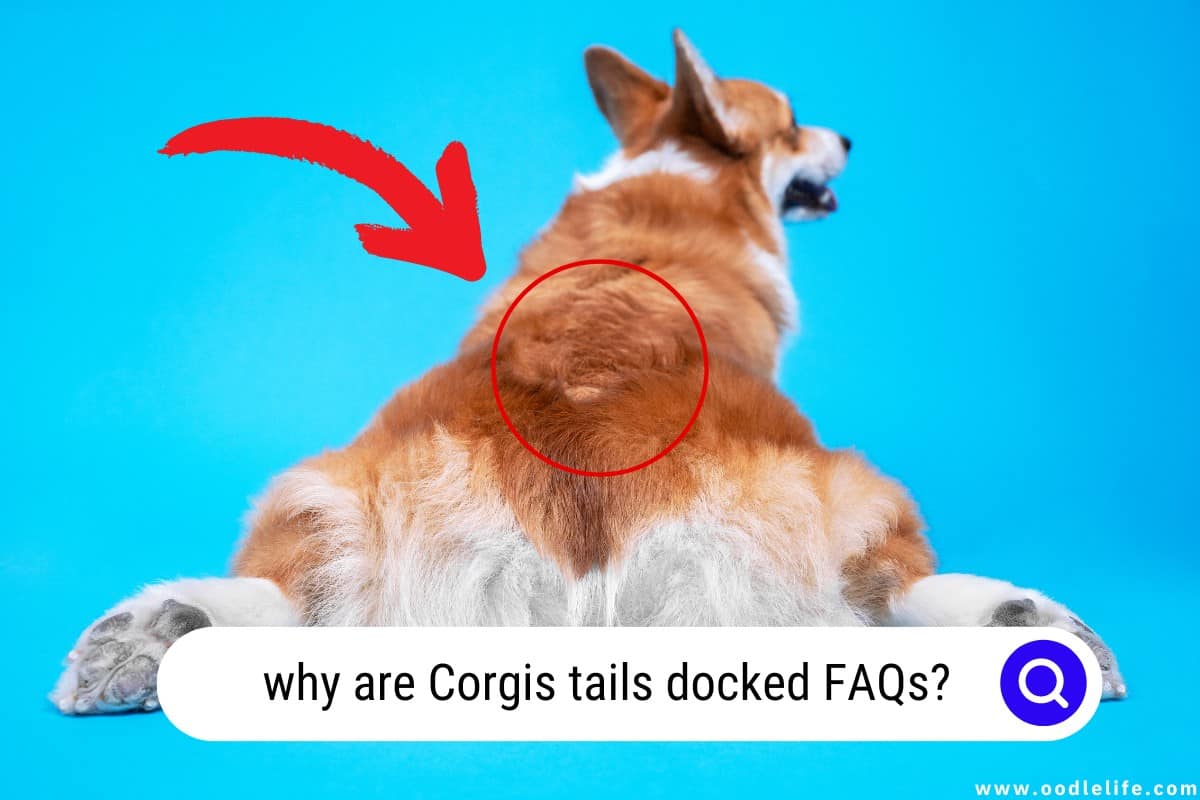
Additionally, selective breeding has led to a portion of the Corgi population being born with naturally shorter tails, making this characteristic even more common among the breed.
Key Takeaways
- Corgis’ tails are often docked for historical and practical reasons related to their herding background.
- Breed standards set by dog show organizations contribute to the continued practice of tail docking in Corgis.
- Selective breeding has resulted in some Corgis being born with naturally shorter tails.
History of Tail Docking in Corgis
Tail docking has been a tradition in some dog breeds for various reasons, including for working dogs on farms. In the case of Welsh Corgis, this breed consists of two types: Pembroke Welsh Corgis and Cardigan Welsh Corgis. The tradition of tail docking is more common in Pembroke Welsh Corgis, while the Cardigan Welsh Corgi tends to have a full tail.

Pembroke Welsh Corgis sometimes have naturally short tails, also known as natural bobtails, due to a genetic mutation. In cases where the tails are not naturally short, tail docking has been done to maintain a specific breed appearance or for working purposes. On the other hand, not all Pembroke Welsh Corgis and almost all Cardigan Welsh Corgis keep their natural tails.
Legend has it that Queen Elizabeth II played a part in popularizing tail docking among the Pembroke Welsh Corgis. Her Majesty is known to have owned more than 30 Corgis during her reign and is a big fan of the breed with the docked tail appearance. However, royal preference aside, the tradition has historical roots and practical reasons.
In the past, Corgis were primarily used as herding dogs, and having a shorter tail was thought to reduce the risk of injury while working on farms. In some countries, tail docking is now banned or considered unethical, leading to more Corgis with their natural tails visible.
So, while you may see a modern-day Corgi without a tail and think someone parted ways with tradition, you’re actually witnessing an evolved perspective on the practice of tail docking. And who knows? Maybe someday, even the Queen’s Corgis will let their tails wag freely, joining their Cardigan comrades in a furry celebration of natural beauty.
Corgis and Their Tails
Corgis, the adorable, short-legged canine companions, come in two varieties: Pembroke Welsh Corgi and Cardigan Welsh Corgi. This section sheds light on their delightful tails and the reasons behind the tail docking practice in the past.
Pembroke Welsh Corgi Tails
Pembroke Welsh Corgis are known for their distinguishable short or “bobbed” tails. In the past, these Corgis’ tails were often docked, or surgically removed, at an early age for cosmetic or working purposes. However, many Pembroke Welsh Corgis are born with naturally short tails referred to as “natural bobtails.”
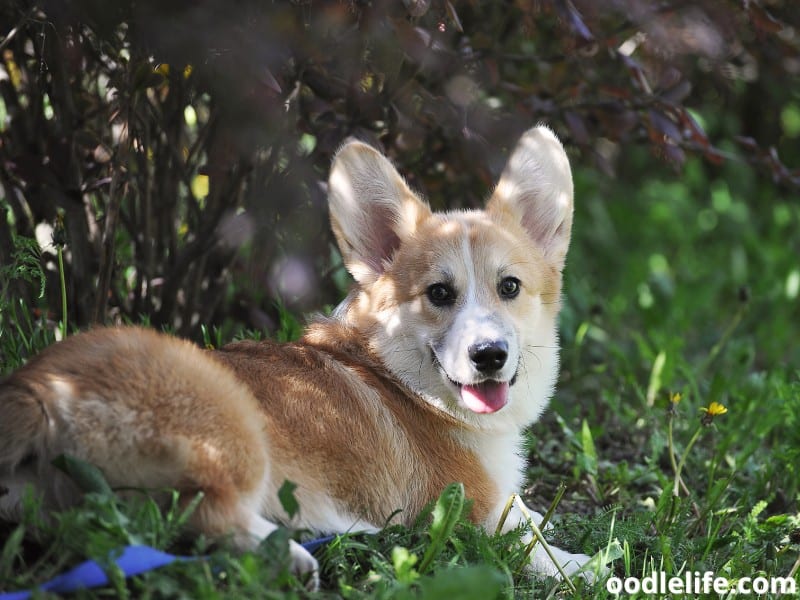
This trait can vary in length – some may have a tail half the length of a full tail, while others may have an entirely tailless rump.
This natural bobtail trait is the result of genetics. It doesn’t affect the Corgis’ ability to wiggle or wag, and they still have full control over their hindquarters. With changing regulations and awareness about tail docking practices, today’s Pembroke Welsh Corgis with naturally long tails are being embraced and celebrated within the breed.
Cardigan Welsh Corgi Tails
On the other hand, Cardigan Welsh Corgis flaunt full-length, bushy tails. Cardigans don’t have a history of tail docking simply because their long, luxurious tails give them a visual distinction from their Pembroke cousins. Think of the tail as a fancy outfit that highlights their unique history and breed personality.
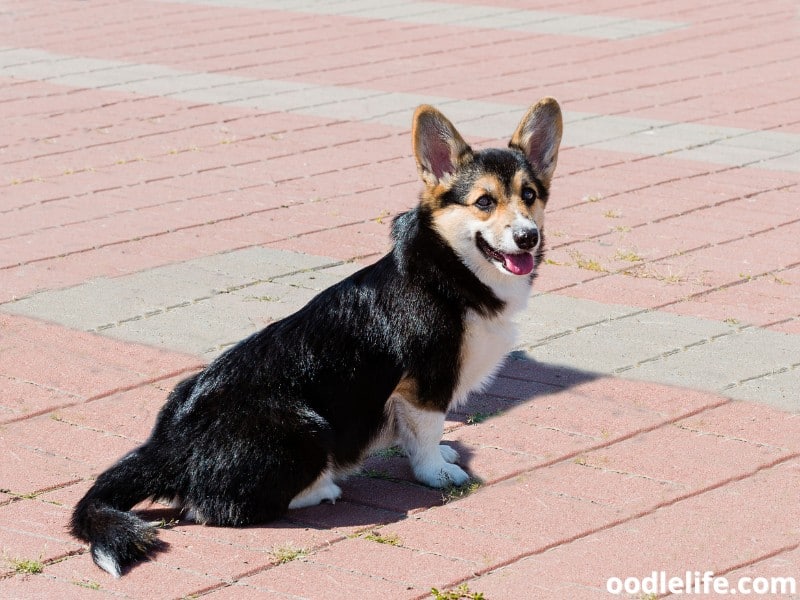
Cardigan Welsh Corgis’ tails serve a functional purpose in their history as working dogs. Their long tails helped maintain balance and stability while herding livestock on the rugged Welsh terrain.
In conclusion, both Pembroke and Cardigan Welsh Corgis have different tail types rooted in their genetic and breed history. As we increasingly value the natural characteristics of these adorable dogs, we can appreciate the beauty of each variety, with or without a tail wagging behind them.
The Docking Process and Its Effects

Health and Well-Being Issues
Tail docking refers to the removal of a dog’s tail, typically done when the dog is a young puppy. Docking is often performed for cosmetic purposes, as some breed standards require short tails. Corgis are one such breed, with their tails historically docked to prevent injuries while herding.
However, some Corgis have a natural bobtail gene that results in a naturally short tail.
The docking process can be a cause of distress and pain for the dog, as the nervous system and bones are involved. While anesthesia may be used to minimize discomfort, there is still a potential risk of complications and a healing period afterward. Docking for health reasons is rare, but it may be necessary in cases where the tail is injured or to prevent injuries in working dog breeds.
Even though the intent behind docking among herding breeds like Corgis might have been more functional, it is essential to consider the potential discomfort, pain, and long-term issues that might arise. Docked tails can affect a dog’s balance, agility, and ability to communicate with other dogs.
Legal and Ethical Considerations
Tail docking has become a contentious issue, with many people advocating for a ban on the practice. Some countries have banned the docking of tails for cosmetic purposes, making it illegal to dock a dog’s tail unless it is medically necessary. In these places, veterinarians can face liability if they perform the procedure without a valid health reason.
Ethical considerations also come into play when it comes to docking Corgi tails. While these dogs have been traditionally docked for herding purposes, many modern Corgis are not engaged in such tasks, posing questions about whether it is necessary or if the breed standard should change. Moreover, the practice can be seen as cruel and unnecessary for those dogs who have a naturally short tail due to the bobtail gene.
The conversation around tail docking is increasingly leaning toward alternatives, such as updating breed standards or promoting the natural bobtail gene in Corgis. However, opinions still vary, and the matter remains an ongoing debate among breeders, veterinarians, pet owners, and animal welfare advocates.
Breed Standards and Dog Shows
Corgis, known for their fluffy fur and adorable waddle, come in two distinct breeds: Pembroke Welsh Corgi and Cardigan Welsh Corgi. Although they share similarities, each breed has its specific breed standards, particularly when it comes to dog shows and the preference of having a docked tail.
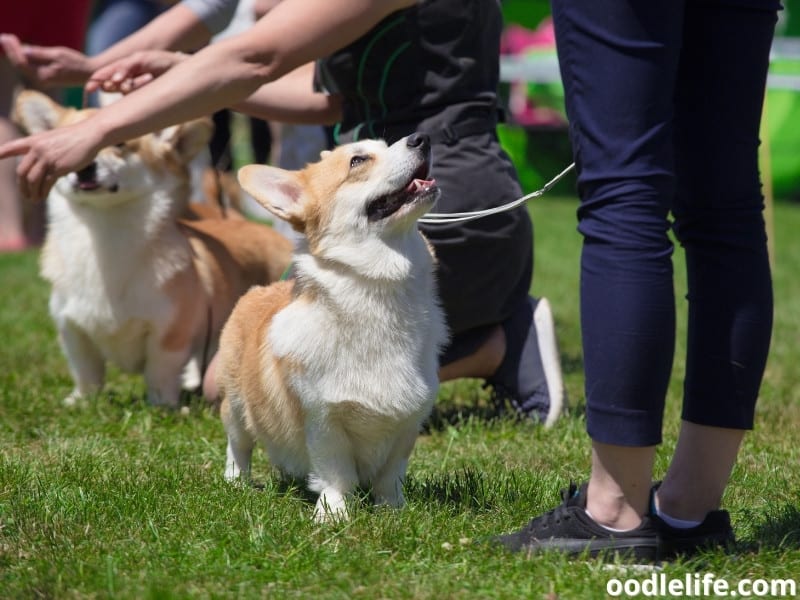
Historically, Corgi tail docking can be traced back to the occupation these breeds were bred for: herding livestock. A docked tail prevented injuries that could have occurred on the job. Today, the practice of docking Corgis’ tails is more closely related to breed standards and dog show appearances.
The American Kennel Club (AKC) sets breed standards for both the Pembroke Welsh Corgi and the Cardigan Welsh Corgi. According to these standards, Pembroke Welsh Corgis have short or nonexistent tails, whereas Cardigan Welsh Corgis have long, bushy tails. Many breeders comply with these AKC standards to maintain their dogs’ eligibility for dog show competitions.
Even the queen’s Corgis, famously associated with Queen Elizabeth II, have traditionally been Pembrokes with docked tails. However, it’s important to note that not all Corgis have to have their tails docked. Pembroke Welsh Corgis can carry a “bobtail gene,” which results in them having a naturally short tail.
Although Corgi tail docking is still practiced in the United States, some countries have banned the procedure. In these places, breeders specifically focus on breeding Corgis with natural short tails to adhere to local laws while maintaining breed standards. As a result, you might see more Corgis with tails in dog shows there.
In essence, while the tradition of Corgi tail docking originates from their historical involvement in the herding field, today, it is mainly influenced by breed standards set by organizations like AKC and the desire to compete in dog shows. However, with growing awareness and regulations surrounding tail docking, breeders in some parts of the world are shifting their focus to naturally short-tailed Corgis.
Genetics and Selective Breeding
Pembroke Welsh Corgis and Cardigan Welsh Corgis are two popular breeds of dogs that showcase some intriguing genetic differences. One major distinction between these canines lies in their tails—while Pembrokes often sport a “bobtail,” Cardigans flaunt a longer, bushier tail.

Let’s dive headfirst into the “tail-tale” of these Corgis. The natural bobtail of Pembroke Welsh Corgis can be attributed to a specific gene. This gene causes their tails to be naturally short or absent, differing from their Cardigan cousins.
Talk about a shake-up in the family tree!
Selective breeding plays a significant role in the appearance and continuation of these traits. Breeders often encourage the natural bobtail gene in Pembrokes because it is considered a desirable characteristic for the breed. On the flip side, undocked tails in many Cardigan Welsh Corgis are the norm.
Sometimes, two different types of Corgi collaborate to create a “pawsome” genetic mash-up! For example, when a Pembroke Welsh Corgi with the natural bobtail gene breeds with a Cardigan Corgi, their offspring may inherit this gene. This outcrossing can lead to the birth of bobtailed Cardigans.
But what about those Pembrokes with the long, flowing tails? Don’t worry, these rare gems exist too. Although the natural bobtail gene is prevalent in the Pembroke breed, not all Pembrokes inherit it.
These lucky dogs get to wag their gorgeous tails just like their Cardigan counterparts.
And that, my friends, is a brief overview of the genetics and selective breeding that contribute to the differences between the tails of Pembroke and Cardigan Welsh Corgis. It’s a fascinating world of genes, tails, and wagging good times!
Corgis in Action: Herding and Working
Corgis, specifically the Pembroke Welsh Corgi and the Cardigan Welsh Corgi, are remarkable working dog breeds with a history deeply rooted in herding and tending livestock. These low-to-the-ground, high-energy pups are more than just adorable Internet sensations – they’re hardworking herding dogs with their roots on the farm.
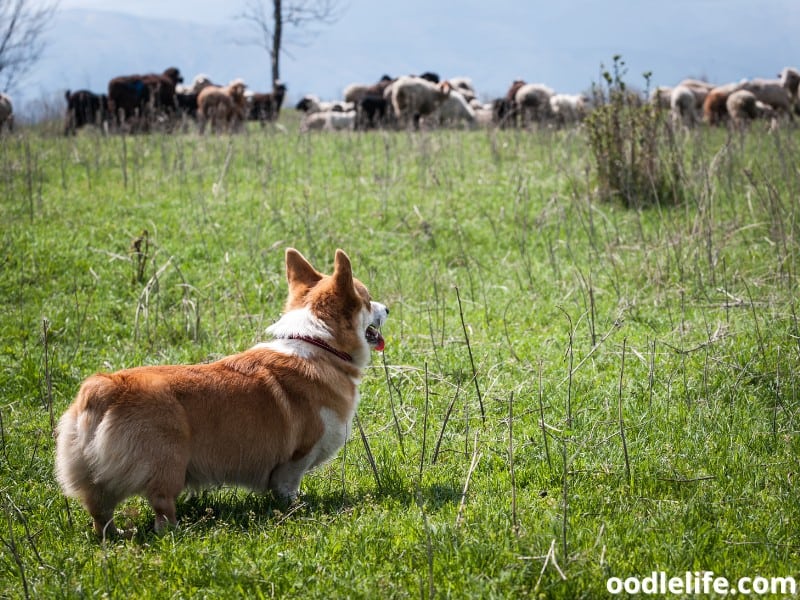
What sets Corgis apart from other herding dogs is their unique approach to the task. Instead of using a forceful presence to push the livestock forward, Corgis employ their trademark “heel snapping” technique. They nip at the heels of cattle, encouraging them to move in the desired direction, while their short legs make it easy for them to evade any retaliatory kicks.
As working dogs, Corgis have a high tail set, which plays an important role in their herding duties. Their tails act as a visual cue for their owners, signaling their location when herding livestock among tall grasses or bushes. However, some Corgis may have naturally short tails, also known as “natural dock,” while others need to have their tails docked for practical reasons.
Docking the tails of working dog breeds, including Corgis, is linked to both hygiene and safety concerns. A docked tail is easier to maintain as it prevents feces or mud from clinging to the fur, keeping the dog cleaner and healthier. Additionally, a shorter tail is less prone to injury, especially for Corgis who spend their days navigating the rocky terrain and thickets that accompany their herding duties.
Historically, in some countries like Britain, farmers were exempt from extra taxes if their working dogs had docked tails. This allowed farmers to easily identify working dogs and differentiate them from pet dogs who might be subject to certain taxes.
To sum it up, Corgis are more than just a cute Internet phenomenon, they are incredibly hardworking, skilled herding dogs with a few quirks. Next time you see a Corgi in action, remember to appreciate the time and effort these little pups dedicate to their herding duties, as well as how their tails (or lack thereof) contribute to their overall efficiency and cleanliness as working dog breeds.
Frequently Asked Questions
Is tail docking necessary for Corgis?
Tail docking is not medically necessary for Corgis. It is done for aesthetic reasons or to adhere to breed standards. However, opinions on this practice vary, and some countries have banned tail docking altogether.
What is the purpose of tail docking in Corgis?
Historically, tail docking in Corgis was done to prevent injury while herding cattle or during farm work. Nowadays, it is more commonly performed to maintain breed appearance standards.
What is the difference between Corgis with and without tails?
The primary difference between Corgis with and without tails is their appearance. Some Corgis have a natural bobtail, while others have their tails docked. Functionally, they remain the same breed with the same traits and abilities.
Are there Corgis that are born without tails?
Yes, some Corgis are born with a naturally short tail or bobtail. This is due to a genetic mutation. However, these bobtailed Corgis are relatively rare and may have slightly different physical characteristics compared to their long-tailed counterparts.
Does tail docking affect Corgis’ health or behavior?
There is not enough evidence to definitively link tail docking to significant health or behavioral issues in Corgis. However, some studies suggest that tail docking may lead to long-term pain, sensitivity, or altered gait and posture. In terms of behavior, Corgis with docked tails usually do not experience any significant differences compared to those with full tails.
Is tail docking a legal practice?
The legality of tail docking varies by country and depends on the specific regulations in place. In some countries, tail docking is illegal, while in others, it is allowed if performed by a veterinarian and if there is a medical reason. It is essential to be aware of the laws regarding tail docking in your country and make an informed decision accordingly.